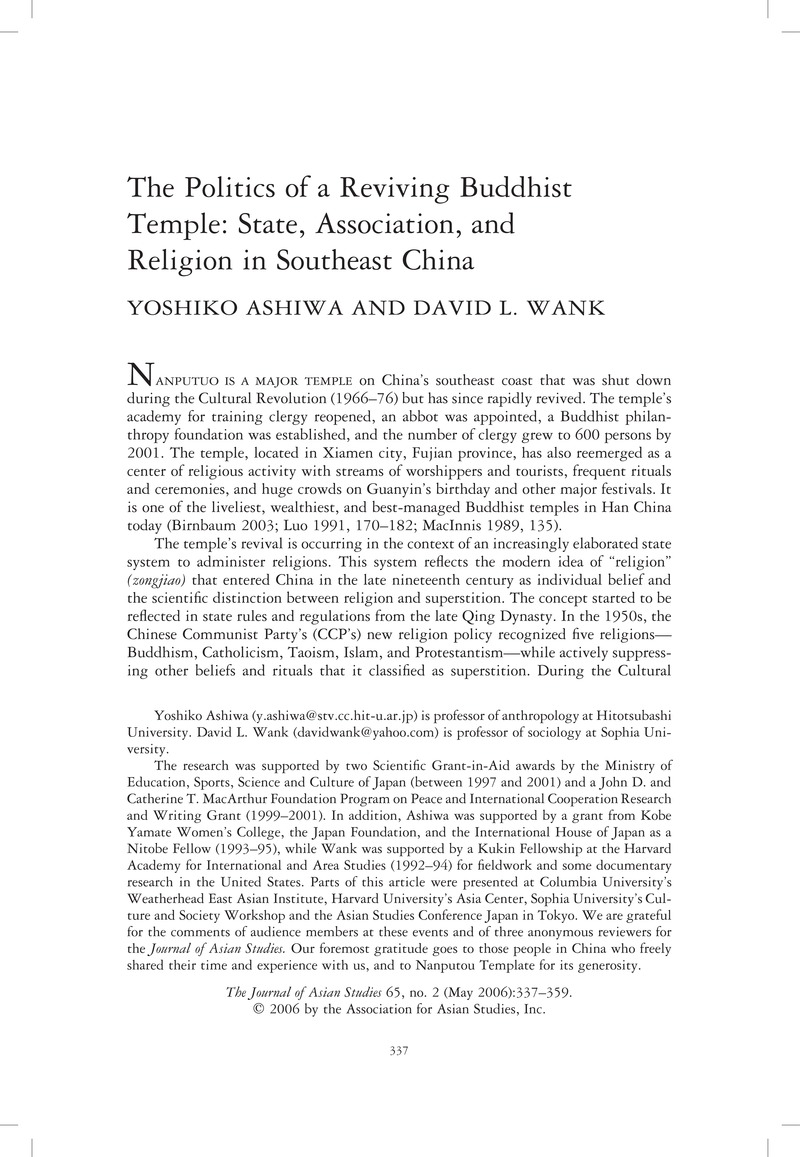Crossref Citations
This article has been cited by the following publications. This list is generated based on data provided by Crossref.
Fisher, Gareth
2008.
The Spiritual Land Rush: Merit and Morality in New Chinese Buddhist Temple Construction.
The Journal of Asian Studies,
Vol. 67,
Issue. 1,
p.
143.
LIN, Wei-Ping
2009.
Local History through Popular Religion: Place, People and Their Narratives in Taiwan.
Asian Anthropology,
Vol. 8,
Issue. 1,
p.
1.
Xiaofei Kang
2009.
Two Temples, Three Religions, and a Tourist Attraction.
Modern China,
Vol. 35,
Issue. 3,
p.
227.
Hoa, Nguyen Kim
and
Turner, Bryan S.
2010.
The Fourth Indo-China War.
Society,
Vol. 47,
Issue. 3,
p.
246.
Fleischer, Friederike
2011.
For the Love of God: Finding Support in the Church-Community: a Case Study from China.
Religion, State and Society,
Vol. 39,
Issue. 4,
p.
443.
Fisher, Gareth
2011.
In the Footsteps of the Tourists: Buddhist Revival at Museum/Temple Sites in Beijing.
Social Compass,
Vol. 58,
Issue. 4,
p.
511.
Trémon, Anne-Christine
2012.
Introduction : L’État au musée. Politiques muséales et patrimoniales dans le monde chinois contemporain.
Gradhiva,
p.
4.
Heise, Ingmar
2012.
Buddhist Funeral Cultures of Southeast Asia and China.
p.
217.
Wong, Cora Un In
Ryan, Chris
and
McIntosh, Alison
2013.
The Monasteries of Putuoshan, China: Sites of Secular or Religious Tourism?.
Journal of Travel & Tourism Marketing,
Vol. 30,
Issue. 6,
p.
577.
Mair, Jonathan
2013.
Buddhism, Modernity, and the State in Asia.
p.
209.
Du, Xingqiang
2013.
Does Religion Matter to Owner-Manager Agency Costs? Evidence from China.
Journal of Business Ethics,
Vol. 118,
Issue. 2,
p.
319.
Du, Xingqiang
Jian, Wei
Zeng, Quan
and
Du, Yingjie
2014.
Corporate Environmental Responsibility in Polluting Industries: Does Religion Matter?.
Journal of Business Ethics,
Vol. 124,
Issue. 3,
p.
485.
Tarocco, Francesca
2014.
Proselytizing and the Limits of Religious Pluralism in Contemporary Asia.
p.
237.
Du, Xingqiang
Jian, Wei
Du, Yingjie
Feng, Wentao
and
Zeng, Quan
2014.
Religion, the Nature of Ultimate Owner, and Corporate Philanthropic Giving: Evidence from China.
Journal of Business Ethics,
Vol. 123,
Issue. 2,
p.
235.
Huang, Ke‐hsien
2014.
Dyadic Nexus Fighting Two‐Front Battles: A Study of the Microlevel Process of the Official‐Religion‐State Relationship in China.
Journal for the Scientific Study of Religion,
Vol. 53,
Issue. 4,
p.
706.
Wu, Keping
2015.
Religion and the Politics of Development.
p.
129.
Niu, Geng
and
Zhao, Guochang
2016.
Religion and Public Trust in Government in Contemporary China.
SSRN Electronic Journal ,
Du, Xingqiang
Du, Yingjie
Zeng, Quan
Pei, Hongmei
and
Chang, Yingying
2016.
Religious atmosphere, law enforcement, and corporate social responsibility: Evidence from China.
Asia Pacific Journal of Management,
Vol. 33,
Issue. 1,
p.
229.
Borchert, Thomas
2016.
Buddhism and the Political Process.
p.
11.
Huang, Dan
Lu, Dong
and
Luo, Jin-hui
2016.
Corporate innovation and innovation efficiency: does religion matter?.
Nankai Business Review International,
Vol. 7,
Issue. 2,
p.
150.



